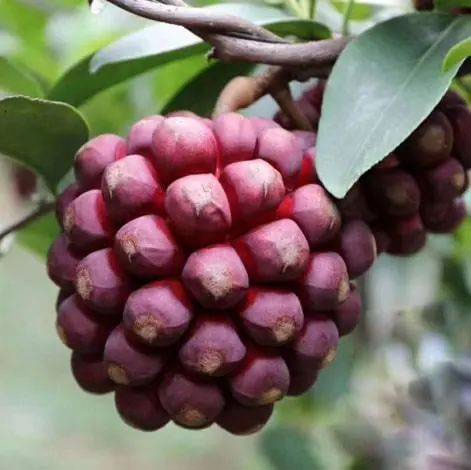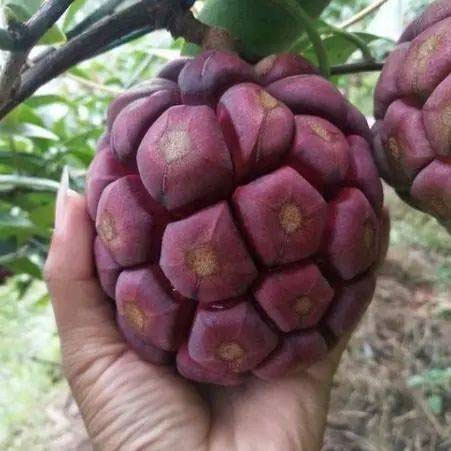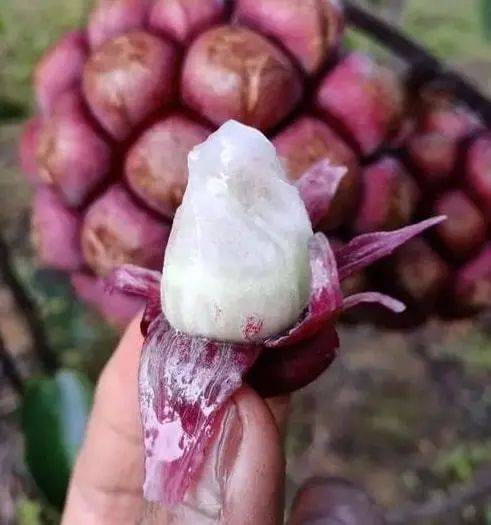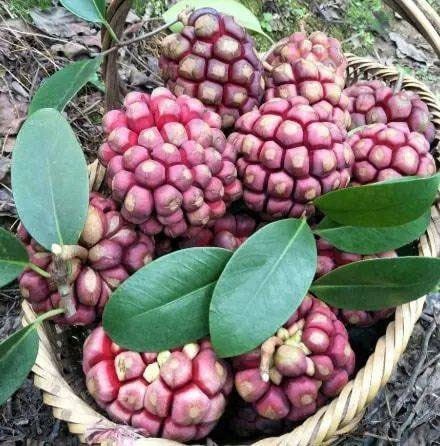This uniquely shaped fruit, resembling a spherical pineapple, has been described by some as a giant lychee with a taste similar to grapes, earning it the title of “the treasure of the people.”
It is said that this fruit closely resembles a type of wild fruit that thrives in coastal marshes, where its seeds take root while still on the tree, yet it bears the name of an animal known as the “king of beasts”, which is linked to a legend.
This humble fruit is highly favored by the Miao people, who have cultivated it for generations. The Miao refer to this fruit as “Bufuna”, meaning “the fruit of beauty and longevity.” This fruit is not simple; it combines the best qualities of pineapples, grapes, and lychees.

The Miao call this fruit the fruit of beauty and longevity.
The Legend of the “Black Tiger Fruit”
During the Tang Dynasty, General Xue Pinggui, while encountering an ambush, fled into the western mountains and fell from his horse due to exhaustion. As he lay on the ground, he caught a glimpse of something black in the distance, mistaking it for a black tiger charging towards him. Consequently, he quickly drew his bow and shot an arrow at the shadow. To his surprise, when the rescuing soldiers arrived, they discovered that what Xue Pinggui had shot was not a black tiger, but a plant resembling a vine with large fruits that looked like a tiger’s head from afar.
This plant, upon being struck by the arrow, released a viscous liquid resembling blood. When Xue Pinggui smelled and tasted it, he found it refreshing. Initially, he thought it was just because he was weak and hungry, so he picked the fruit to eat, not realizing it would not only restore his strength but also heal his internal injuries.
After witnessing the power of this wild fruit, Xue Pinggui ordered more to be gathered for his soldiers to quell their hunger, quench their thirst, and help them regain their strength to defeat the enemy and break free from the siege. This fruit-bearing plant, known as “Black Tiger Fruit” or “Hắc Hổ,” has been passed down through generations.
The “Black Tiger Fruit,” a Treasure Among People
The distribution of the “Black Tiger Fruit” is mainly concentrated in the deep southern mountains, including regions of Hunan, Guizhou, Sichuan, Fujian, Guangdong, Guangxi, and Hainan. It typically grows at altitudes of 1500-2500 meters in rice forests, along mountain streams, and in humid valleys.
This plant has unique characteristics, especially its fruit, which is striking and unforgettable at first glance. The flowering period of the “Black Tiger” tree is from April to July, and the fruiting period is from July to November.

This fruit looks like a spherical pineapple.
The shape of this fruit is quite unique, resembling a spherical pineapple, with some claiming it to be a giant lychee. When ripe, it has a general color of reddish-purple, appearing very attractive. If picked and a piece of the flesh is broken off, peeling away the thin outer skin reveals a creamy white interior resembling lychee, tasting sweet yet reminiscent of grapes.

However, the Black Tiger has a “minor flaw”; like lychee, it contains seeds, making it somewhat inconvenient to eat as one must spit out the seeds.
The Miao have cultivated the “Black Tiger” for generations, not just for its edibility as a fruit but because it is considered “a treasure among people” due to its high medicinal value. In traditional medicine, “Black Tiger” can also replace black licorice (a remedy for cancer prevention). This comes from the story of Jiao Hong, a great physician of the Jin Dynasty, who, while treating a woman in need of black licorice, could not find any and ultimately discovered “Black Tiger” in nature, which proved to be a better substitute than black licorice.

When ripe, it has a general color of reddish-purple, appearing very attractive.
In fact, the “Black Tiger” plant not only produces edible fruit but its roots, stems, leaves, and fruits can all be used as medicine to help clear heat, detoxify, dispel wind and cold, activate energy, relieve pain, nourish the liver, and promote blood circulation, among other functions.
Additionally, the “Black Tiger” is also a high-end ornamental plant, often grown in gardens with its jade-green leaves and lush branches. Moreover, this plant can bloom multiple times a year, producing flowers in various colors such as red and yellow, with a long flowering duration.
The visually appealing fruit resembles a hanging pineapple, with a taste similar to grapes but an interior reminiscent of lychee, prompting many businesses to invest in large-scale cultivation to attract and expand the “agricultural tourism” model.


















































